When Europeans first arrived in North America they often struggled to survive in the unfamiliar wilderness they encountered. For many early colonists, the help of the Native American peoples was a godsend. Because they were familiar with the plants, animals and climate of America, the natives had an amazing ability to find the food they needed, often without farming at all. The new arrivals learned some of those skills, and were able to keep themselves fed.
Of course the colonists quickly established farms, built towns and recreated the sophisticated European societies they’d come from. Quite soon, most of them were buying food as they needed it from markets, butchers and bakers. Agriculture and early food processing – by the 17th century beef and pork were being salted on an industrial scale, for example – meant food was available all year round.
The Native Americans lived a very different lifestyle. Most of them were nomadic or lived in small settlements. They usually lived off the land, as hunter-gatherers – and that meant sometimes they had more food than they could eat, while other times they struggled to find any at all.
To survive they had to find ways to preserve the surplus so it was available in the lean times. They did find ways to do that, and those methods can still be valuable to preppers today. Here are some of the main ways Native Americans prepared food for storage.
Drying
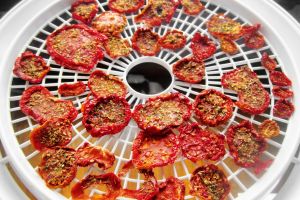 Almost all foods have a very high water content. Most fruit and vegetables are around 90% water by weight, and some of them are above 95%. Meat contains less moisture, but even then it’s usually somewhere between 70% and 75% water.
Almost all foods have a very high water content. Most fruit and vegetables are around 90% water by weight, and some of them are above 95%. Meat contains less moisture, but even then it’s usually somewhere between 70% and 75% water.
Related: How to Build a Solar Dehydrator
Generally this is fine; we need water to survive, and usually we get a lot of it from our food. It’s a different story if you’re trying to preserve food, though. We’re not the only ones that need water to survive; the bacteria and other organisms that make food spoil need it, too. More importantly, they don’t just need it to survive – they need it to reproduce. If you can remove most of the water you can slow their reproduction dramatically. Food that would spoil in a couple of days can last for months – or even years – if you can remove enough of the water.
Native Americans loved dried food. Not only could it be safely stored for much longer, but with the water removed it was a lot lighter. Many Native Americans were semi-nomadic, either following the game they hunted or moving between summer and winter areas. Dried food was more compact and, importantly, nowhere near as heavy; that meant they could carry much more of it.
Many preppers already know the benefits of drying food. I have a dehydrator in my kitchen, and as well as making jerky I use it to turn fruit into trail snacks, dry surplus herbs and dehydrate vegetables to add to home-made MREs.
Native Americans obviously didn’t have access to electric dehydrators, though, so instead they used the energy of the sun. Many tribes made drying racks from branches, and hung thin strips of meat or other food over them so the sun and air could evaporate their water content. Children and old people watched over the food as it dried, driving off insects and scavengers. If you’re drying food on a rack yourself a less manpower-intensive solution is to cover the rack with a mosquito net.
Another way to dry food is to lay it in the sun on flat stones. The stones can be heated in a fire first to speed up the process, but if they get too hot the food can end up cooked rather than dried.
Smoking
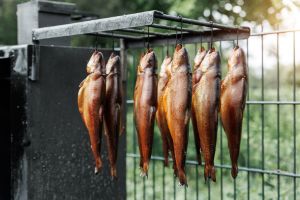 Smoking has many of the benefits of drying; it reduces the water content of food, slowing down the spoiling process. It can also coat or impregnate it with substances from the smoke that help to preserve it even better.
Smoking has many of the benefits of drying; it reduces the water content of food, slowing down the spoiling process. It can also coat or impregnate it with substances from the smoke that help to preserve it even better.
As a bonus, smoking also adds a distinctive flavor.
Native Americans smoked meat and fish, turning them into compact but tasty and nutritious foods that would last for months. They did this by building wooden racks, laying the food on them then leaving it in the smoke from wood fires for days.
Nomadic tribes had special tipis that were only used as smokehouses; tribes that built permanent villages used a hut or an underground room instead. If you don’t have a smokehouse, you can learn here how to build a cheap smokehouse in your backyard. The woods used were often selected for the flavor they gave the food, with hickory being a favorite.
When Native Americans butchered an animal, lean meat was usually dried. Ribs and fattier cuts were good candidates for smoking.
Rendering
Drying and smoking work best with lean meat; both processes will remove the moisture from meat, preventing spoiling, but the oils in fat can still turn rancid over time. If you make jerky you know how important it is to use the leanest meat possible, and the Native Americans knew this too.
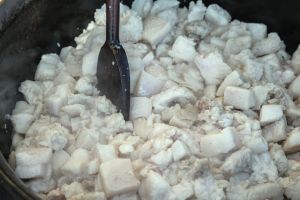
They didn’t want to waste the fat, though; it’s also a valuable source of energy and nutrients. When they butchered an animal, Native Americans would cook the fatty parts on a hot stone or in a pan to render the fat out, making it easier to store.
Related: How to Make Long-Lasting Tallow for Survival
The most famous of their survival foods, pemmican, was made from rendered fat, pulverized dried meat and dried berries; it was high in protein and energy, and would last right through a long winter. Rendered fat was also used for cooking and medicinal poultices.
Salting
Salt is a very effective natural preservative, and Native Americans who lived near the coast were well aware of its value as a food preservative.
They collected salt by letting seawater evaporate in shallow ponds, then gathering and drying the salt it left behind.
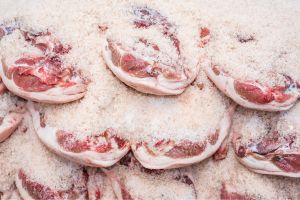 The Chickasaw people, who originally lived in the southeastern US, preserved meat by salting it – their name for it was Nipi hapayimma. Meat could be salted by cutting it in strips then rubbing the surface with salt as it dried.
The Chickasaw people, who originally lived in the southeastern US, preserved meat by salting it – their name for it was Nipi hapayimma. Meat could be salted by cutting it in strips then rubbing the surface with salt as it dried.
Alternatively it could be soaked in strong brine for around a month.
With the brine method herbs and spices were sometimes added to the solution to give the meat more flavor.
Freezing
Like salting, freezing wasn’t a method all Native Americans could use – but those who could, did.
 In winter, hunters would butcher the animals they killed then take the meat they didn’t plan to eat right away and bury it in snowdrifts. Once it had frozen, it would be removed from the snow. If the tribe was moving, the frozen meat could be wrapped in a hide and the cold air would keep it frozen until it was needed.
In winter, hunters would butcher the animals they killed then take the meat they didn’t plan to eat right away and bury it in snowdrifts. Once it had frozen, it would be removed from the snow. If the tribe was moving, the frozen meat could be wrapped in a hide and the cold air would keep it frozen until it was needed.
If they were settling in for the winter it could be stored in a pit or root cellar to protect it from animals.
Burial
Even today we preserve some foods by burying them. Potatoes are often stored in “clamps”; lay some straw on the ground, pile the potatoes (or other root vegetables) on it, cover them with more straw, then pile earth over the whole thing and dig a drainage ditch around it.
Native Americans also buried food for storage. Some tribes ate potatoes – these spread through the Americas before Europeans arrived – and most ate corn, squash and other vegetables.
All of these could be preserved for weeks, sometimes longer, by burying them in a pit lined with dry grass. Earth makes a great insulator, protecting buried food from the heat.
The modern world has many ways of preserving food. Any grocery store will sell us a wide range of dehydrated, canned and frozen food, and these are great options for building up your stockpiles.
But even your stockpile might run out during a prolonged crisis. That’s why it’s important for all of us to become as self-sufficient as possible. We don’t all need to become cattle ranchers, but keeping a few chickens and maintaining a small garden can provide an endless supply of food. For more information, check out this guide on how to create a year-round, self-sustaining garden and start living independently.
But when those modern resources are gone, and you’re looking for ways to preserve the food you’ve grown, hunted or foraged for yourself, the old Native American methods work just as well now as they did centuries ago.
If you know how to use them, you’ll be able to preserve food to get you through the winter and other hard times.
You may also like:
The ‘Superweed’ That Saved Large Communities During the Great Depression (Video)
Why You Should Put a Silver Coin in Water
6 Ingenious Projects for Endless Hot Water Without Electricity

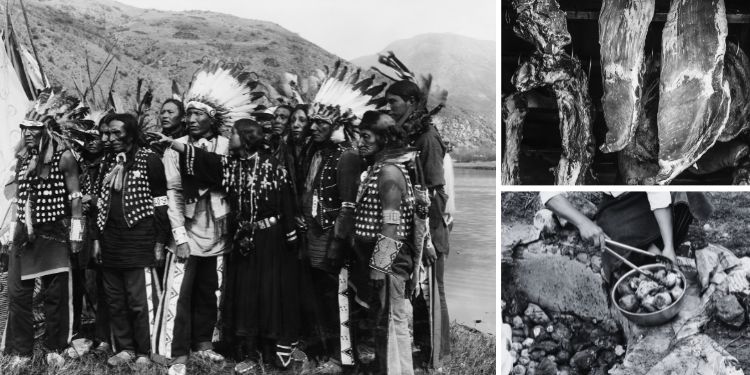














Nothing better than the smoke flavor of fish, have done this method an prefer it for fish.
Freezing fish is okay, but may not be a good option if the grid goes down for electricity to run a refrigerator.
The average home solar system bis for emergency use, not for long term electricity to run a refrigerator at this time period. Unless you are wealthy enough to have a battery backup added and even though it could crap out when needed.
Other news:
In California, San Diego area several incidences were school district buses were attempted by open border illegals to ride on buses with school children on them. Incidences reported to law enforcement and border patrol.
If many Demoncrats vote for Harris-Walz, these incidences will become much more dangerous for our kids and bus drivers this November election.
I wouldn’t want to live in that area, scary stuff!
https://fox5sandiego.com/news/local-news/migrants-attempt-to-board-school-buses-in-east-county/
What America do you want to live in and keep your kids safe?
Native Americans were the America first preppers we can learn from too.
Speaking of food related story of preserving food.
https://frontlineamerica.com/kamala-harris-under-fire-failing-border-policies-lead-to-chaos-and-crime-in-florida/
Our food chain supply is in jeopardy from with from Harris-Walz open borders..
She says she will fix the border, what?
What was VP Harris doing with Biden as border czar, letting in the world, now says she will fix the problem they caused in the first place?
What would the Native Americans do today?
How can anyone attribute the challenges with borders to one person in a short time span? The original colonist’s to the America’s were looking for a better place from their European nations where the rich controlled the country. They destroyed the centuries of Native American culture for the promise of freedom and a better life. When analyzing the reason for the immigration challenges the USA experiences, the similarities of our nation’s past are very apparent. This country is made up of only 2.9% Native Americans. WE (myself of German/Irish descent) have immigrated to this land. To believe that one presidential administration is going to make a difference is absurd. Former president Trump didn’t stem the tide and as a Republican, I am tired of his antics as well as those I have tried to support by electing them into Congress. It’s all a sham to keep the people cowering to a false ideal that any crooked politician from any political party can make a difference. Look at the history of the USA and see that when we integrated the immigrants into our society, that is when America was great again. Yes, we need to have an effective border policy to stem the dangerous people but it’s the white wealthy people who are bringing in the drugs and guns. Look at how the wealthy Kennedy’s made their money bootlegging alcohol from Canada. The wealthy people of this country are to be held accountable. If the current system is changed, they lose money. Our Congresspeople are beholden to the wealthy rather than the original framework “of the people.”
Back then at least the Native Americans had non GMO food to work with.
Under the Burial segment author writes about endless food supply, of gardens and chickens. There eventually both need an infusion of outside DNA to maintain good quality. If chickens keep inter breeding than if genetic defects can occur from internal breeding. Similar to humans who marry their first cousins of interbreeding can have effects on us. No different than eating GMO and bioengeered food on grocery shelves. The covid vaccines rushed through without clinical trials done. Pushed by Biden-Harris covid mandates. Many forced vaccines giving to our military ended with on going health issues.
How long do these food techniques last for long term storage use before the foods spoil? How can we tell when these foods spoil, what signs do we see besides the obvious mold?
What is the comparison with the modern survival prepper foods out there in today’s formats we can purchase?
Learning traditional low tech preservation techniques also means shifting from modern attitudes about what is edible. Meat preserved by drying, salting, corning, smoking might get moldy, but you scrape the mold off and eat it. You might find a few maggots in a piece of jerky, just cut ’em away and slice it thin. Cheese and bread get moldy, but there’s nothing else and you have to eat. Rancid food isn’t spoiled, just don’t taste good. Spices were a God send in Middle Ages Europe because they made off smelling meat taste better. In traditional medicine the most common and effective treatments are treatments for an upset stomach, common problem with a rough diet. A great delicacy among tribal peoples in the Pacific Northwest was whole salmon buried in the dirt until it fermented completely, was then dug up in the winter and enjoyed by all. I could walk down to the creek bottom below our house and shoot a squirrel, gather some coarse greens and cattail shoots and fix up a meal but instead I bought a nice tasty chicken at the fancy store in town this morning, spice it up with tasty herbs, bake a potato and drown it in fresh sweet butter, enjoy with several helpings of unsweet tea and vodka. Hoping to sleep in a soft warm bed the rest of my days.
Not native to Arizona, arriving in the mid 50’s … my mother had heard about dried meat, jerky, and decided to attempt making it. No privately owned dehydrators in private homes in the 1950’s, and while an oven would work on low heat, that is a lot of wasted gas, living on a budget. Living in Arizona, where the norm for the summer is 60+ days of temps over 100 degrees … she cut beef into 1″ square cubes. Marinated the meat in a salt / vinegar brine, then rolled the cubes in coarse ground pepper. Then with a carpet needle, and kite string … ran the needle through the peppered cubes, and literally, hung the uncooked meat cubes on our clothesline in our backyard … until the cubes were dried, and hard as rocks.
I now would be worried about flies and insects on the meat, but perhaps the salty brine soak, and rolled in course pepper, denied those insects a treat. she would then pull the meat down, pull the string out, and store in varied covered bowls and margarine containers … for kids snacks.
The joy of being given a treat of a hard chunk of beef. Break off part with your teeth, and hold in your mouth letting saliva soften it, so you could chew it, and absorb the salty peppered meat was amazing. And we never got sick from the meat sitting outdoors for days and days.
cheese cloth and black pepper will keep the bugs off of the meat. we never got sick from natural foods or river, or spring water from the hillsides. garden hoses at the neighbors house.. i truly believe that we had a natural acquired immunity to a lot of things through Scouting at that time. us boys would eat or drink anything and we never got sick. we were like wild Indians.
to this day, and i’m 65, if i come across water in the woods i have no hesitation about taking a drink if i’m thirsty…. honestly, i would rather have that than the crap that comes out of our faucets nowadays.
Hi Orion ,….I was wondering if the little dried cubes would soften up say in a month or two if you put them in a pot of boiling water…and some edible plants to make some kind of a soup during hard times ? So it would not be so hard on people with bad teeth and gums .and still get a balanced dinner . Or does very dried out meat stay pretty much hard ? Thanks , I like the meat on a string idea your mother did . thanks for sharing .
Whoever wrote this article missed world history class! If they didn’t, they would know that the skilled European market and trade system, that the colonists brought to America, was preceded by all of the basic skills they give full credit to native Americans and that those basic skills were still an integral part of their market and trade system!
if the native Americans had not shown the first Europeans how to survive here, many of the first arrivals would have starved.
i’ll bet that many natives wish that they could have a do-over on that one.
True, from their perspective, we were the illegal aliens! 🥴
After receiving your book The lost ways I’m sorry to say I was not very impressed or happy with your product although reading it was very informative. All of the pictures are in black-and-white and pictures of some of your weeds and roots were mixed in with the field of other weeds and roots and extremely difficult to pick out since they’re all the same color color is very when it comes to picking any kind of vegetation plus the pictures of cooking were also in black-and-white most of them look like black cast-iron skillets cooking charcoal overall, I’m not very pleased with the book. You show all the nice pretty pictures on your website in color , which would’ve been very nice if it had been that way in your book most of the pictures look like they were taken in the 1800s extremely disappointed I wished I had examined what I was getting before I purchased it
Please remove the ads from the content of the articles.
It is difficult to read with 1/3 of the article behind ads that
I have seen hundreds of times on this site. Don’t need to
see them again.
Please remove the ads from the content of the articles.
It is difficult to read with 1/3 of the article behind ads that
I have seen hundreds of times on this site. Don’t need to
see them again. AND NO, I HAVE NOT ALREADY SAID
THIS
1